The data you collect from your customers is a goldmine for creating tailored email campaigns that address various customer touchpoints.
The way we communicate, shop, and interact with brands has dramatically shifted over the past decade.
For small businesses, having a strong online presence isn’t just about staying competitive—it’s about survival. It’s an absolute necessity without which the brand will cease to exist.
But let’s be clear: digital marketing isn’t a one-and-done effort. It requires a consistent investment of your time and creativity to keep your brand momentum thriving.
Does that mean you should dive headfirst into every strategy labeled as “digital marketing”?
Not at all—and realistically, you couldn’t even if you tried.
But with this blog post, you can focus on the top digital marketing strategies that have been proven to boost brand visibility, expand reach, and drive sales.
However, before we explore…
What is digital marketing and why is It important?
Digital marketing is the use of digital (online) channels to promote your business’s products or services to its intended audience. It involves the use of channels such as social media, emails, search engines, and websites to generate awareness and bring conversions to your business.
We wouldn’t say that traditional marketing methods are redundant. But today, these methods work in tandem with digital marketing to amplify your marketing efforts.
Look around and you will find endless stats all pointing toward the dominance of digital strategies for business marketing. Businesses today are spending more (nearly 70%) of their budget on different digital channels to drive their brand momentum, sales, and traffic.
Of course, digital marketing is important, and here’s why:
- Offers global reach allowing you to target audiences worldwide
- Allows specific audience targeting based on demographics and psychographics
- Performance tracking to measure the impact of digital strategies in real-time
- Offers specific analytics to understand customer behavior and preferences better
- Build long-lasting relationships and better engagement with the audience
- 24*7 availability offering businesses the opportunity to connect with customers anytime, anywhere
- Offers better ROI for small and medium-scale businesses
Top digital marketing strategies for small businesses
A lot fits within the broad definition of digital marketing. And as exciting as it’s to try your hands on everything, it’s not feasible.
So we’ve created this list of 9 strategies that every small business can start with. Use them individually or pair them with other strategies to amplify the results.
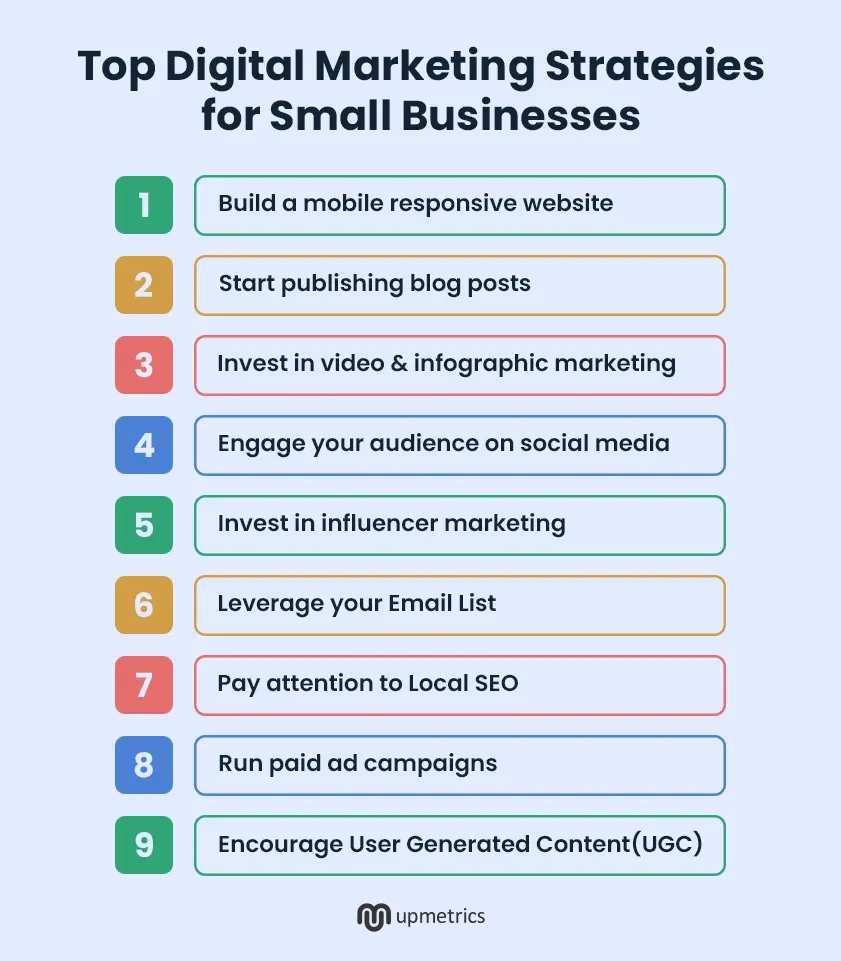
1. Build a mobile responsive website
According to a Statista study, mobile devices (excluding tablets) account for nearly 60 percent of web page views worldwide. Meaning the majority of your audience visits your website while scrolling through their handy devices.
Without saying, your website needs to be optimized for their mobile screens and tablets. If not, you’re risking their user experience and ultimately your potential to capture sales. Not to mention, you’re downplaying your brand’s reputation in the market.
As you focus on mobile responsiveness, here are the key points you should keep in mind:
- Responsive design
- Faster load speeds
- Readable texts
- Multimedia optimization
- Clear CTAs
- Minimal pop-ups
- Touch friendly navigation
Ideally, businesses should adopt a mobile-first approach, instead of thinking of mobile-responsive websites as an afterthought. As Steve Schoger, the designer at Tailwind says, you have to go beyond the basics of fitting contents on a small screen to make mobile responsiveness work.
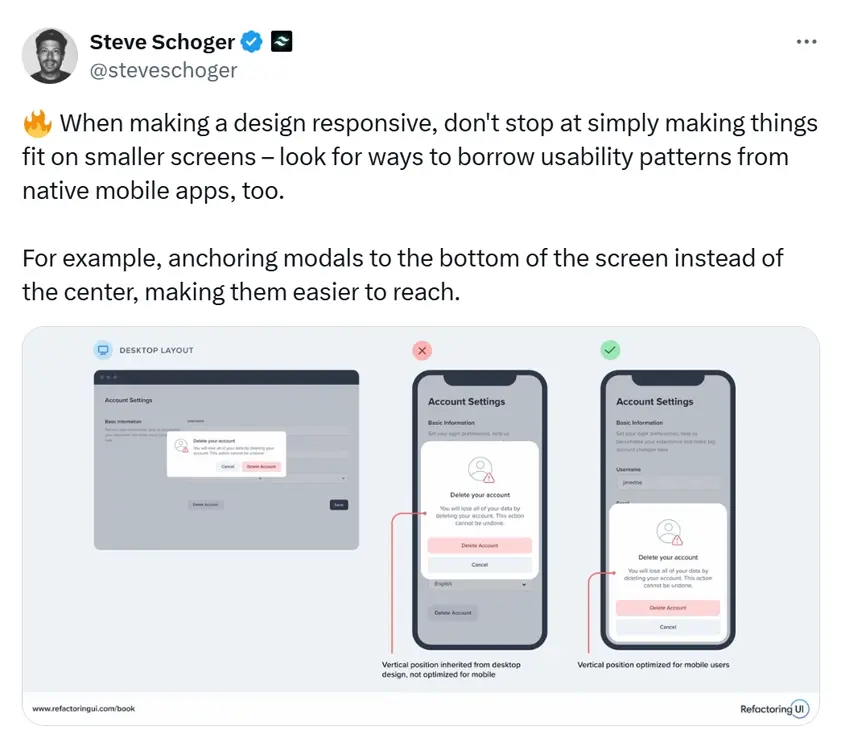
2. Start publishing blog posts
Blog posts are the simplest form of content marketing that can establish the business’s authority in its niche. Not to mention, it’s a critical factor influencing your search engine rankings.
As you build the blog repository for your website, keep the SEO perspective front and center. Make sure that you understand the search intent of your target audience and incorporate keywords naturally throughout the engaging thread.
While scrolling through the archives, came across this tweet by Kaleigh Moore, a freelance writer, who has written for brands like AT&T, Stripe, IBM, Shopify, and BigCommerce.
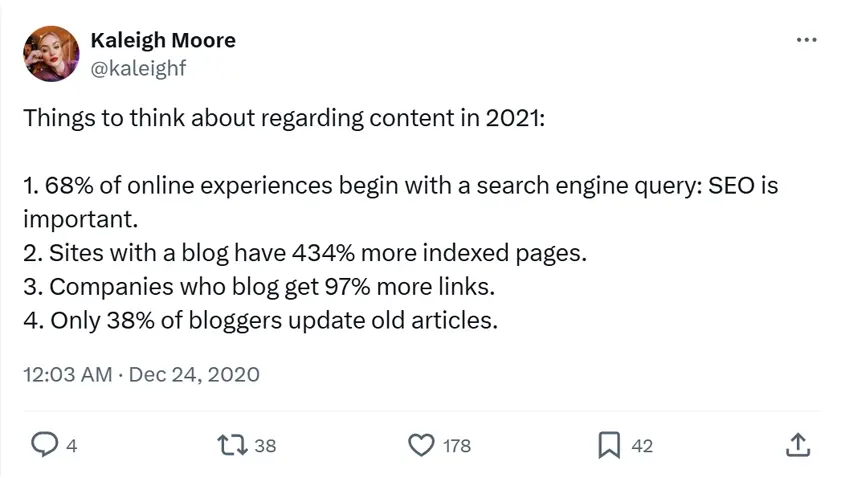
While the stats have changed a bit by now, the message still remains the same—well-researched and informative blog posts boost SEO the most.
So what sort of content you should be publishing on the website?
- Thought leadership articles
- Insights on industrial trends
- Case studies
- Use cases
- Comparison posts
- Branded articles
- Newsletters
- Interactive buyer guides
- And much more..
Small businesses with limited budgets can automate certain aspects of blog posts with AI. However, make sure that you don’t chase the publishing race with poorly researched and non-authoritative content. To get the best results, they can consider mixing LLM synthetic data with human input.
3. Invest in video and infographic marketing
Anthony Gaenzle is listed amongst the top 50 content marketers, currently managing the content and strategy at Synapse.
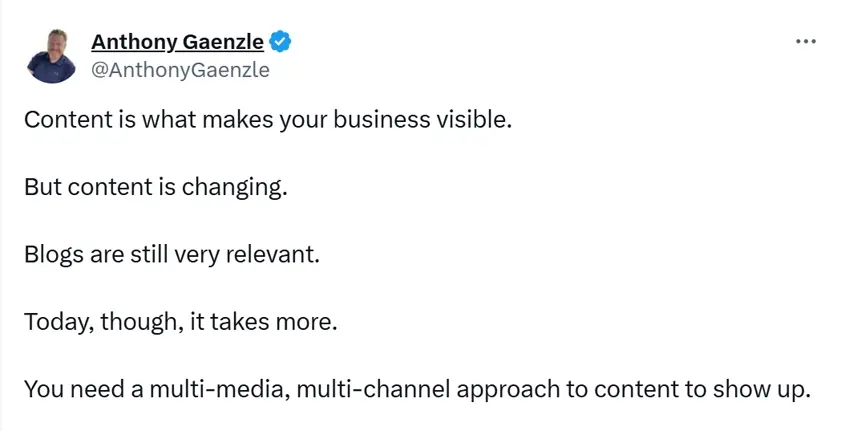
According to him, you simply cannot rely on high-value blog posts to do everything for you. Yes, they play a role in driving engagement and even bringing conversions. But you need to include more visuals—specifically infographics and video content for your marketing campaigns.
No matter what business you are in, your existing customers and potential customers want to see more branded videos. And it’s quite easier now given the increased number of automated video makers and AI tools.
However, it’s important to analyze your target audience to see what sort of content they like to engage with.
To offer a few ideas, here are some video aspects you can choose to cover:
- Product reviews
- BTS (behind-the-scenes)
- Guided product tour
- How to videos
- Funny or informational videos
- ASMR videos
Similarly, for visually appealing infographics, generate high-value images that can clarify concepts, ease product understanding, and highlight your brand.
Now, repurpose this content for different marketing channels and campaigns to weave a unique narrative and ultimately a strong online presence.
4. Engage with your audience on social media platforms
Small or large, every business is capitalizing on social media marketing to boost its brand’s presence. And rightfully so. After all, social commerce is bringing unparalleled reach and amplified increases in sales.
However, social media is a competitive place. Small businesses can’t possibly tap into all the platforms at once and tbh there’s no need for it. Simply pick the best-performing social media channels for your target audience and develop your marketing campaigns accordingly.
To give you a quick overview, Facebook, Instagram, LinkedIn, X(formerly Twitter), TikTok, YouTube, and Pinterest are some of the top-performing social media platforms for marketers.
Now, before you start pushing the content on your chosen social media channels, make sure that you have a solid purpose. This will ensure that your marketing campaigns create an everlasting brand impression.
As Janet Machuka, a Social Media & Content Marketing Expert quotes:

Here’s a quick cheat sheet you can use to align your social media campaigns with a purpose:
| Purpose | Action |
|---|---|
| Increase sales | Run limited-time offer ads and create shoppable posts on Instagram and Facebook. |
| Increase brand visibility | Use trending hashtags, reels, and video content on Instagram and TikTok. |
| Increase engagement | Post polls, quizzes, or Q&A stories and host live sessions on Facebook or Instagram. |
| Drive website traffic | Share blog links with strong CTAs; use Instagram link stickers and Google Ads. |
| Build trust and credibility | Leverage user-generated content (reviews, testimonials, unsponsored reviews) to build social credibility. Also, post case studies and behind-the-scenes content. |
| Launch a new product | Use teaser campaigns and countdown posts across your top social media channels. |
| Boost event attendance | Create Facebook event pages, share highlights from past events, and run geo-targeted ads. |
Lastly, make sure that you follow the principles of corporate identity while building campaigns for different channels. That is, maintain consistency with campaigns’ visual, typographical, and contextual elements to build an easy to recall brand.
5. Invest in influencer marketing
Influencers are the new breed of trusted voices in digital advertising. And no, celebrities aren’t the only influencers influencing people.
As Cody Wittick, the CEO at Kynship, in his influencer marketing thread says:
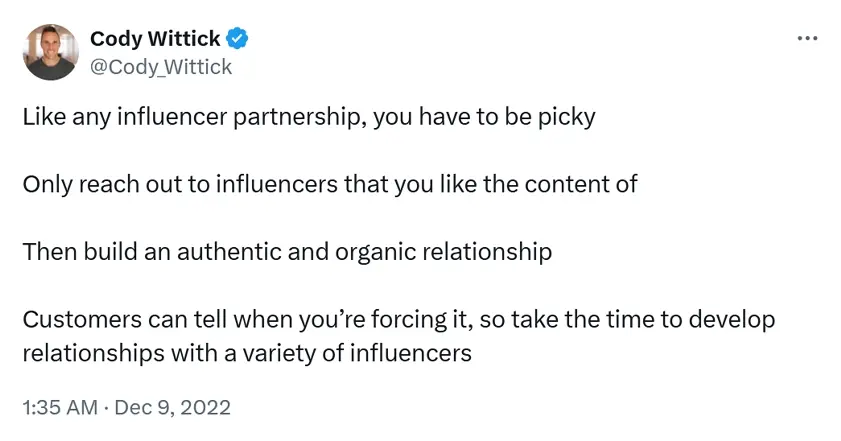
Yet another insight by David Park that emphasizes hiring a right-fit influencer for your business.
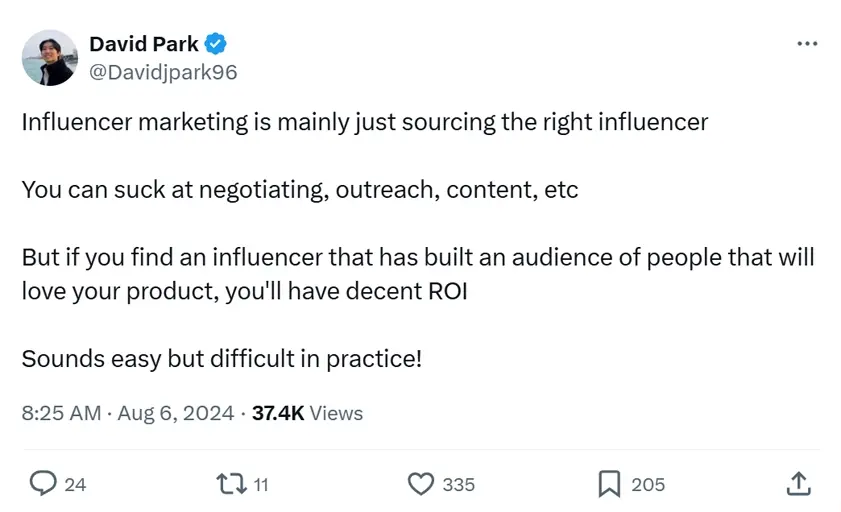
The influencer brings an understanding of the customer that the brand simply can’t get on its own. With insights from an influencer, the brand is capable of developing products that resonate even more with their target customer.
Ideally, every business should be working with influencers moving forward. More so, if yours is a business related to tourism, food, lifestyle, fashion, fitness, and tech.
Now, you don’t need kickass budgets to hire influencers. Small businesses can start by collaborating with a few nano influencers (niche small audience) generally similar to their target audience. Doing so can provide the much-needed boost and support to influence your existing and new customers.
6. Leverage your Email List
Email marketing is a time-tested strategy that remains relevant even today. Despite these other techniques, there are businesses that generate millions of dollars in revenue all hinged to their excellent email marketing strategies.
The data you collect from your customers is a goldmine for creating tailored email campaigns that address various customer touchpoints. Before diving into full-scale campaigns, it’s a smart move to initiate an email warm up process. This helps build a strong sender reputation and improves deliverability, ensuring your emails actually reach the inbox rather than the spam folder.
Start by making sure you create a business email that looks trustworthy—this builds credibility and helps avoid spam filters right from the start.
By utilizing effective data integration, you can improve your understanding of customer behavior and preferences. Whether it’s building trust, driving engagement, or boosting sales, email marketing allows you to stay connected with your audience effectively.
Here’s how you can strategically use your email campaigns to achieve specific goals:
| Purpose | What should you do? |
|---|---|
| Build relationships | Send personalized welcome emails and anniversary messages. |
| Promote your content | Share blog posts, videos, or guides through weekly newsletters. |
| Generate leads | Offer gated content like eBooks, webinars, or free trials in exchange for email sign-ups. |
| Market your products | Announce new products, seasonal sales, or exclusive offers. |
| Nurture leads | Send drip campaigns addressing customer pain points and showcasing solutions. |
Even small businesses with limited staff and expertise can benefit from email marketing if they can automate their emails for different customer lifecycle events.
Here’s a checklist by Joe Portsmouth that may come in handy:
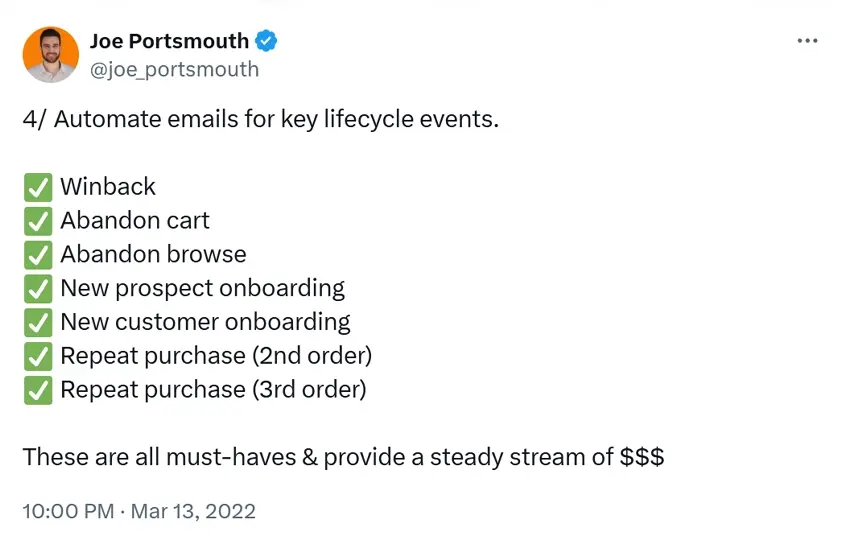
Lastly, track the analytics and use the insights to guide your campaigns for maximum ROI.
7. Pay attention to Local SEO
Businesses serving a specific geographic area or physical location business such as restaurants, salons, garages, cafes, grocery stores, and retail outlets can benefit greatly from local SEO. Set SEO goals to ensure you’re targeting the right audience and optimizing your website effectively for local search visibility.
Consider it as the digital equivalent of your store window. If you’re not optimizing there, you are missing out on exceptional opportunities.
Here’s how a local business can optimize their local search results:
- Build your Google My Business (GMB) profile: Make sure that you add accurate information like address, operating hours, business details, and contact information
- Include local keywords: Add geo-specific keywords such as “ restaurants near me” to enhance search relevance
- Gather reviews: Gather verified reviews and testimonials for your GMB listing and respond to build credibility
- Add pictures: Include high-quality pictures of your product and service offerings
You can also try these to enhance your GMB profile further:
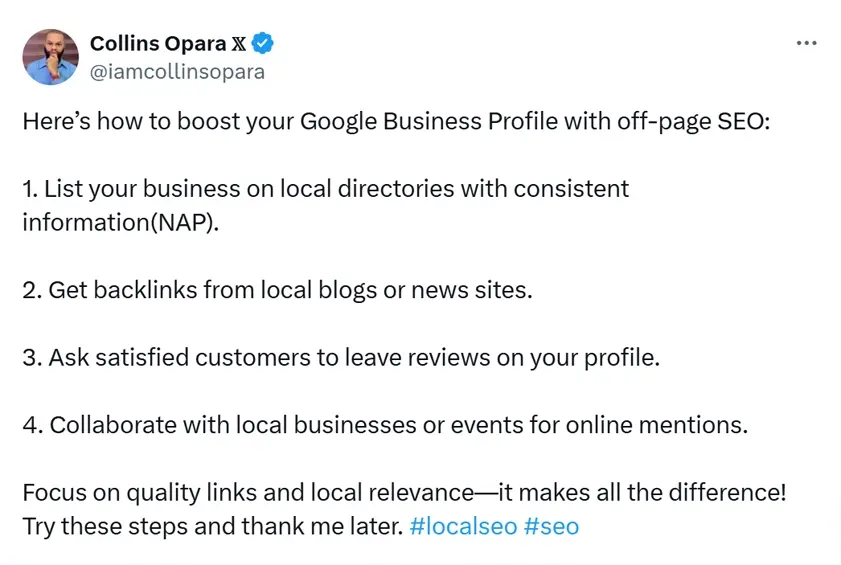
In short, make this strategy locally exclusive to garner attention from your specific audience. You can also build SEO partnerships with local influencers, bloggers, or businesses to earn backlinks and local search mentions.
8. Run paid ad campaigns
Generating organic traffic takes time (a lot of time). You simply cannot rely on it to bring you closer to your target audience. Paid ad campaigns step in to help target your specific audience and engage prospective customers who are likely to want your product or service.
Although running ad campaigns is expensive, if executed right, they can bring super quick conversions and an increase in revenue.
To bear in mind, here’s a checklist of things you need to optimize and take care of while running a paid ad:
- Choose the right platform: Google ads aren’t the only thing. If your target audience is a social buyer, target relevant platforms
- Target the right audience: Have a very specific understanding of the demographics and psychographics of your intended audience
- Specific ad formats: Static, videos, carousels—understand and choose the ad format that works for your audience and market
- Optimize the landing page: Paid ads are supposed to bring conversions, so make sure that the landing page is optimized
- Monitor and pivot: Religiously track the ad campaigns, analyze Google ads data along with other social platform insights to identify what’s working, and discard the non-performing campaigns.
George Clements who is doing exceptional work with Google and YouTube Ads, encourages people to experiment with different ad variations. This will help identify the most effective messaging and visuals for your audience that converts.
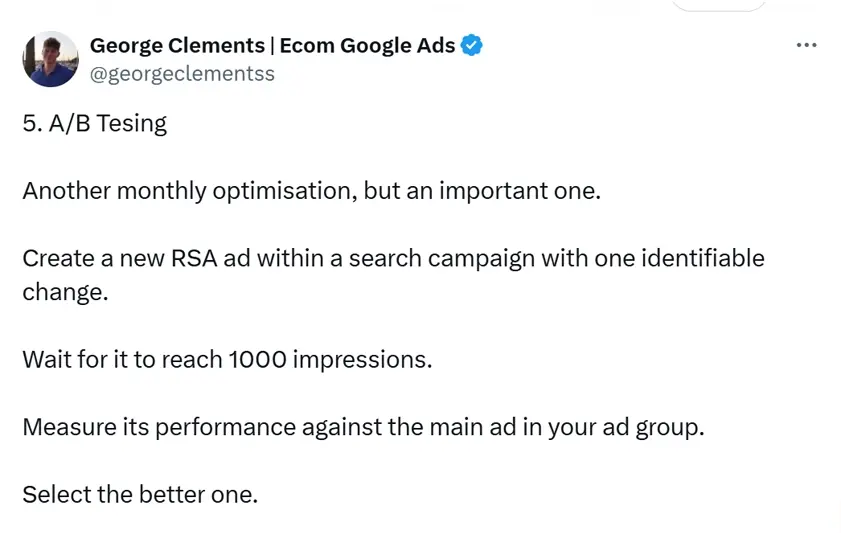
9. Encourage User Generated Content(UGC)
Scroll through social media and you will see people flaunting their Dyson Airwrap, the latest iPhones, or the iconic Sambas.
Mind you, these aren’t the influencers sponsored by brands. But real people who love these brands so much that they take pride in flaunting them on their social media.
That’s the essence of User-Generated Content (UGC)—well, one aspect of it. In reality, UGC can be in the form of social media updates, reviews, blog posts, videos, and podcasts.
Brand loyalists are another ripe source of UGC. They’re real people who love these products and take pride in sharing their experiences on social media.
If you’re not leveraging or encouraging user-generated content, you’re missing out on a powerful way to build trust and authenticity.
As Chris Do, personal and business brand development specialist says:
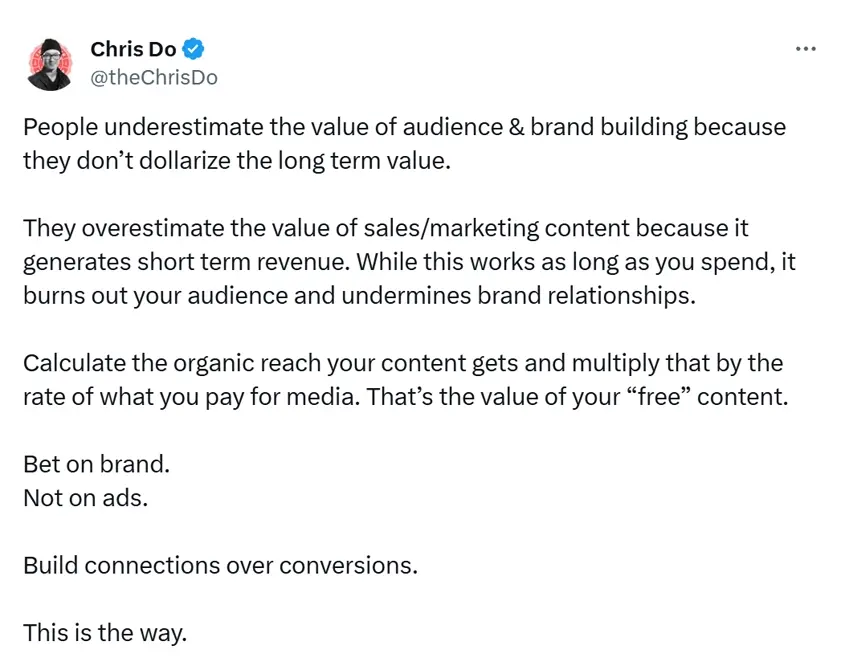
For small businesses, here are a few ways you can encourage UGC for your brands:
- Run contests and quizzes on social media
- Create buzz for your brand
- Leverage hashtags
- Incentivize reviews and testimonials
- Feature customer stories or case studies
- Launch a referral or rewards program using tools like ReferralCandy, which makes it easy to automate and manage customer referral incentives
That’s it. There are many other strategies we haven’t discussed here, however, if the digital marketing landscape is to be summarized:
- Integrate SEO with everything
- Produce multi-media, multi-channel content as much as possible
- Run ad campaigns to make your products sell
Everything else falls within these broad categories. And with that, we wrap 9 terrific digital marketing strategies a small business owner can kickstart with.
Common digital marketing mistakes small businesses make
The right digital marketing approach can offer countless opportunities for your business to grow. However, without the right approach, you would just be draining your money getting no defined results.
It’s a long learning curve, exploring each of these marketing strategies to its full potential. However, with this list, you can avoid the common mistakes that most small businesses make:
- Not having a clear strategy: Jumping into marketing without defined goals or a plan often leads to wasted efforts
- Focusing Too Much on Sales Content: Excessive promotional posts without value-driven content can disconnect the audience
- Expecting Immediate Results: Don’t abandon your digital marketing strategy when you don’t see instant results
- Not engaging with an audience: Not responding to comments, reviews, or messages can disrupt customer relationships
- Neglecting Analytics and Insights: Not tracking performance metrics will over time waste your money
- Ignoring SEO Basics: Neglecting SEO will fail even the most optimized content programs
Conclusion
By now, you have a list of marketing strategies that are proven to grow small businesses. However, deciding on strategies isn’t enough.
You need a roadmap and a solid plan to implement each of these strategies and track their performance. A well-detailed marketing plan is what you need.
With Upmetrics, you can create an actionable marketing plan to attach to your business plan. Not only will it guide your marketing efforts, but it will also help align your sales and operational goals, ensuring that your entire team is working towards the same objectives.

